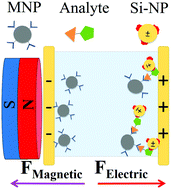当前位置:
X-MOL 学术
›
Nanoscale Horiz.
›
论文详情
Our official English website, www.x-mol.net, welcomes your
feedback! (Note: you will need to create a separate account there.)
Novel electro-magnetophoretic separation method for the highly sensitive detection of analytes†
Nanoscale Horizons ( IF 8.0 ) Pub Date : 2019-08-23 , DOI: 10.1039/c9nh00279k Giorgia Giovannini 1, 2, 3 , Francesco De Angelis 1, 2, 3
Nanoscale Horizons ( IF 8.0 ) Pub Date : 2019-08-23 , DOI: 10.1039/c9nh00279k Giorgia Giovannini 1, 2, 3 , Francesco De Angelis 1, 2, 3
Affiliation

|
The detection of a low concentration of biomarkers required for an early diagnosis remains a tricky task to pursue. In this context, magnetic nanoparticles (MNPs) have been widely used to isolate/concentrate diluted samples. However, by applying the magnetic field, all MNPs are isolated, both those conjugated with the analyte and free MNPs. This excess of MNP can interfere with the analyte quantification. Herein, we propose a novel and versatile approach that ensures the selective isolation of the analyte-conjugated MNP by exploiting the electrophoretic and magnetophoretic behavior of respectively charged silica nanoparticles (SiNPs) and MNPs. In this work, the robustness and sensitivity of the developed isolation and fluorescence-based detection procedure were confirmed by comparing them with the standard method based on simple magnetic isolation of the analyte. The limit of detection (LOD) is improved by two orders of magnitude, namely, from 1 nM to 10 pM. This finding confirms the potentiality of the method and its possible application in the development of rapid and easy-to-use point-of-care devices.
中文翻译:

新型的电磁磁分离方法,可高度灵敏地检测分析物†
早期诊断所需的低浓度生物标志物的检测仍然是一项艰巨的任务。在这种情况下,磁性纳米颗粒(MNP)已被广泛用于分离/浓缩稀释的样品。但是,通过施加磁场,所有的MNP都被隔离了,包括与分析物结合的MNP和游离的MNP。MNP的过量会干扰分析物的定量。本文中,我们提出了一种新颖而通用的方法,该方法通过利用分别带电的二氧化硅纳米颗粒(SiNPs)和MNP的电泳和磁致行为,确保与分析物偶联的MNP的选择性分离。在这项工作中,通过与基于简单分析物的简单磁性分离的标准方法进行比较,确认了已开发的分离和基于荧光的检测程序的鲁棒性和灵敏度。检测限(LOD)提高了两个数量级,即从1 nM到10 pM。这一发现证实了该方法的潜力及其在快速,易于使用的即时护理设备开发中的可能应用。
更新日期:2019-12-17
中文翻译:

新型的电磁磁分离方法,可高度灵敏地检测分析物†
早期诊断所需的低浓度生物标志物的检测仍然是一项艰巨的任务。在这种情况下,磁性纳米颗粒(MNP)已被广泛用于分离/浓缩稀释的样品。但是,通过施加磁场,所有的MNP都被隔离了,包括与分析物结合的MNP和游离的MNP。MNP的过量会干扰分析物的定量。本文中,我们提出了一种新颖而通用的方法,该方法通过利用分别带电的二氧化硅纳米颗粒(SiNPs)和MNP的电泳和磁致行为,确保与分析物偶联的MNP的选择性分离。在这项工作中,通过与基于简单分析物的简单磁性分离的标准方法进行比较,确认了已开发的分离和基于荧光的检测程序的鲁棒性和灵敏度。检测限(LOD)提高了两个数量级,即从1 nM到10 pM。这一发现证实了该方法的潜力及其在快速,易于使用的即时护理设备开发中的可能应用。











































 京公网安备 11010802027423号
京公网安备 11010802027423号